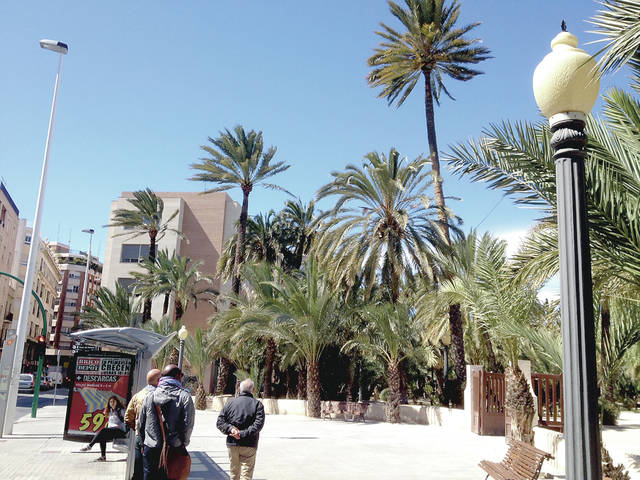Hawaiian gardens are famous for the hundreds of species of palms from all over the world. Coconut palms are a favorite but another genus is equally important in many tropical and subtropical regions. It is the Phoenix group. We often see Pygmy Date Palms in home landscapes, but we seldom see the tree that produces the edible date. This is the palm referred to in the Bible and Quran and has been in cultivation for thousands of years. It is the palm that played the role of commemorating the triumphal entry of Jesus into Jerusalem at the beginning of Holy Week. Date Palms or Phoenix dactylifera have been important around the Mediterranean in the hot dry climates of North Africa, and the Near East since prehistoric times. They are famous for their succulent edible fruit with more than 1,000 varieties and are hardy palms that can be grown in warm temperate to tropical regions. All parts of the tree are used. Wine and sugar are made from the sap. Hats, mats and thatch are made from the leaves. In fact more than 800 uses have been counted. Date palms can live to 200 years or more and reach 100 feet in height.
Hawaiian gardens are famous for the hundreds of species of palms from all over the world. Coconut palms are a favorite but another genus is equally important in many tropical and subtropical regions. It is the Phoenix group. We often see Pygmy Date Palms in home landscapes, but we seldom see the tree that produces the edible date. This is the palm referred to in the Bible and Quran and has been in cultivation for thousands of years. It is the palm that played the role of commemorating the triumphal entry of Jesus into Jerusalem at the beginning of Holy Week. Date Palms or Phoenix dactylifera have been important around the Mediterranean in the hot dry climates of North Africa, and the Near East since prehistoric times. They are famous for their succulent edible fruit with more than 1,000 varieties and are hardy palms that can be grown in warm temperate to tropical regions. All parts of the tree are used. Wine and sugar are made from the sap. Hats, mats and thatch are made from the leaves. In fact more than 800 uses have been counted. Date palms can live to 200 years or more and reach 100 feet in height.
Close relatives like Canary Island Date palm may even be grown as far north as coastal Oregon and Southern England. The edible Date Palm is extremely salt tolerant and will do well in Hawaii along windy beaches where coconut palms have trouble surviving. It is highly ornamental for locations where most palms would not survive.
Christians all over the world celebrate Palm Sunday for it is said that Jesus rode into the city on a donkey while crowds spread their clothing and palm leaves on the road before him. They shouted “Hosanna to the Son of David,” and “Blessed is he who comes in the name of the Lord,” to honor him as the long awaited Messiah and King. Many thought he had come to free them from the Romans and some believed He had come to set them free of their sins. He had come to fulfill the prophecy of Zechariah. The donkey was the symbol of peace and laying of palm leaves indicated the King was arriving in victory.
Today Catholic countries all over the world celebrate the blessing of palms followed by a big procession to church and Mass. Of course the rest of Holy Week is based on serious drama that recognizes the crucifying and the resurrection of Jesus. The palm leaves are sometimes burned and the ash used on Ash Wednesday.
The prophet Mahomet (Muhammad) said to the Arabs, “Honor the Date Palm for it is your Mother.”
There are over seventeen species of Phoenix or Date Palms. The most common in Hawaii are the Pygmy Date Palms or Phoenix roebellini originally from Laos. Another specie, Phoenix sylvestris, is common growing wild along the north shore of Oahu. In its home of India, the fruit is not used but the sap is valuable for palm sugar, toddy and wine. Other species used in the landscape are Phoenix reclinata, a clumping form from East Africa and Phoenix rupicola, with single trunk and soft, arching leaves from India to Siam.
Most species are easily grown from seed including the edible date. Next time you buy a container of dates, you can save the seed to grow your own trees. Simply soak the seed in water for a few days. Place them in a community pot with seeds slightly covered with potting soil. Keep the soil moist and warm. Within a few months you will have the first seed leaves emerge and you may then place each seedling in individual pots. Fertilize with a balanced liquid formula once a month. Since date palms are initially slow growing, it may be a year or more before they are ready to plant in the garden. Be sure to give them plenty of room and remember the leaves of most species are armed with thorns. The pygmy Date Palm is best for small gardens, but if you have room many other species are hardy and tolerant of harsh conditions.
Since Easter is next Sunday, be sure to buy some Easter lilies to dress your home for the holidays. Next week’s garden column will give you tips on how to plant them in your garden and store the bulbs for future Easters as well.
Contact the UH Master Gardener Helpline for palm information at 322-4893 in Kona and 981-5199 in Hilo.



